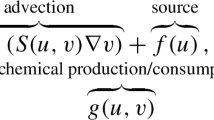Abstract
Because of the long term persistence of free-running circadian rhythms in populations of unicells, several investigators have considered, but not demonstrated, a possible role for intercellular interaction in maintaining synchrony between individual cells. The experiments described here were designed to test more critically the possibility that there is interaction between cells, including those possessing only small phase differences. None was detected; the bioluminescent glow of the mixed cultures matched the algebraic sum of the independent control cultures.
Similar content being viewed by others
References
Bünning, E. (1973),The Physiological Clock, Springer Verlag, Berlin.
Karakashian, M. W., and Hastings, J. W. (1962),Proc. Natl. Acad. Sci. 48, 2130.
Njus, D., Gooch, V. D., and Hastings, J. W. (1981),Cell Biophys. 3, 223.
Pye, E. K. (1969),Can. J. Bot. 47, 271.
Ghosh, A. K., Chance, B., and Pye, E. K. (1971),Arch. Biochem. Biophys. 145, 319.
Hastings, J. W., and Sweeney, B. M. (1958),Biol. Bull. 115 440
Brinkmann, K. (1966),Planta 70, 344.
Edmunds, L. N., Jr. (1974), inBiochronometry (Menaker, M., ed.), National Academy of Sciences, Washington, DC, pp. 594–611.
Mergenhangen, D., and Schweiger, H. G. (1974),Plant Sci. Lett. 3, 387.
Dharmananda, S., and Feldman, J. F. (1979),Plant Physiol. 63, 1049.
Fogel, M., and Hastings, J. W. (1971),Arch. Biochem. Biophys. 14, 310.
Hastings, J. W. (1960), inBiological Clocks (Chovnick, A., ed.),Cold Spring Harbor Symp. Quant. Biol. 25, 131.
Hastings, J. W., and Bode, V. C. (1962),Ann. New York Acad. Sci. 98, 879.
Dunlap, J. C., Taylor, W., and Hastings, J. W. (1980),J. Comp. Physiol. 138, 1.
Enright, J. T. (1965),J. Theoret. Biol. 8, 426.
Author information
Authors and Affiliations
Rights and permissions
About this article
Cite this article
Sulzman, F.M., Van Gooch, D., Homma, K. et al. Cellular autonomy of theGonyaulax circadian clock. Cell Biophysics 4, 97–103 (1982). https://doi.org/10.1007/BF02918306
Received:
Accepted:
Issue Date:
DOI: https://doi.org/10.1007/BF02918306




